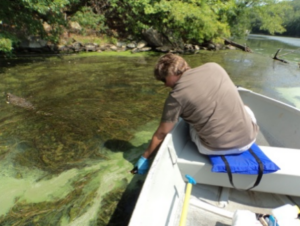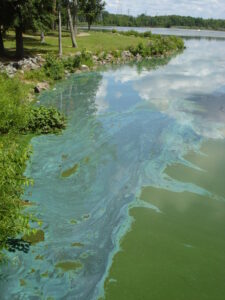
CyanoHABs
Cyanobacteria
Cyanobacteria are a type of bacteria capable of photosynthesis. Although they are not true algae, they are often referred to as “blue-green algae.” Cyanobacteria frequently impart off-tastes and odors to the water in which they grow, and sometimes they produce toxins that can be harmful to the health of humans and other animals. Although problems related to cyanobacteria most often occur in freshwaters (lakes and streams), cyanobacteria can also be found in marine waters.
Cyanobacterial Harmful Algal Blooms (CyanoHABs):
A cyanobacterial Harmful Algal Bloom (HAB) is the name given to the excessive growth, or “bloom,” of cyanobacteria, some of which can produce one or more types of potentially harmful toxins (cyanotoxins). DEP defines a HAB as a density of identified cyanobacterial cells of 20,000 cells/ml or higher. HABs often occur under suitable environmental conditions of light, temperature, nutrient enrichment, and calm water. These blooms can result in a thick coating or mat on the surface of a waterbody, frequently in late summer or early fall, but blooms can occur year-round.
Cyanobacteria cells
Exposure to cyanobacteria cells themselves, whether or not the bloom is actively producing cyanotoxins, may cause allergenic and/or irritative effects to a portion of an exposed population. These effects are caused by endotoxins (mainly from components of the cyanobacterial cell wall) rather than cyanotoxins. It has been established that some sensitive individuals have adverse allergenic/irritative responses from exposure to cyanobacterial cells at concentrations as low as 5,000 cells/ml (USEPA, 2019).
Cyanotoxins
Cyanobacteria can produce toxins that are dangerous for humans, pets, livestock and wildlife. The toxins produced by the cyanobacteria are referred to as cyanotoxins. Cyanotoxins can be produced by a wide variety cyanobacteria.
Most common cyanotoxins
Based on the surveys that have been carried out to date in U.S. waters, the most commonly identified cyanotoxins are microcystins, cylindrospermopsins, anatoxins and saxitoxins. Additional information on CyanoHABs, including other states’ activities, is available on the EPA CyanoHABs website.
| Cyanotoxin | Acute Health Effects in Humans | Most Common Cyanobacteria Producing the Toxin |
| Microcystins | Abdominal Pain, Headache, Sore Throat, Vomiting and Nausea, Dry Cough, Diarrhea, Blistering around the Mouth, Pneumonia, Liver Toxicity. | Dolichospermum (previously Anabaena), Fischerella, Gloeotrichia, Nodularia, Nostoc, Oscillatoria, members of Microcystis, and Planktothrix |
| Cylindrospermopsin | Fever, Headache, Vomiting, Bloody Diarrhea, Liver Inflammation, Kidney Damage | Raphidiopsis (previously Cylindrospermopsis), raciborskii (C. raciborskii), Aphanizomenon flos-aquae, Aphanizomenon gracile, Aphanizomenon ovalisporum, Umezakia natans, Dolichospermum (previously Anabaena) bergii, Dolichospermum lapponica, Dolichospermum planctonica, Lyngbya wollei, Raphidiopsis curvata, and Raphidiopsis mediterranea. |
| Anatoxin-a group | Tingling, Burning, Numbness, Drowsiness, Incoherent Speech, Salivation, Respiratory Paralysis Leading to Death | Chrysosporum (previously Aphanizomenon) ovalisporum, Cuspidothrix, Raphidiopsis (previously Cylindrospermopsis), Cylindrospermum, Dolichospermum, Microcystis, Oscillatoria, Planktothrix, Phormidium, Dolichospermum (previously Anabaena) flos-aquae, A. lemmermannii Raphidiopsis mediterranea (strain of Raphidiopsis raciborskii), Tychonema and Worochinia |
Information on how NJ handles cyanobacterial harmful algal blooms can be found on the Cyanobacterial Harmful Algal Blooms (HABs) Response Strategy web page.
Primary Cyanotoxins and their Associated Human Health Effects (USEPA HABs website)
More information on Harmful Algal Blooms can be found on the DEP’s HAB Website
Purpose
- The Cyanobacterial Harmful Algal Bloom (HAB) Freshwater Recreational Response Strategy provides a unified statewide approach to responding to HABs in recreational waters and sources of drinking water and to protect the public from risk associated with these toxins. There are no content changes to the Strategy for 2024; guidance and thresholds remain aligned with current science. The strategy will be updated in 2025.
- Response Plan is a component of the Response Strategy and is designed to identify:
- Entities responsible for response and actions, including various divisions within NJDEP as well as the NJDOH and the NJ Department of Agriculture (DoA)
- Recreational risk thresholds for concentrations of pertinent toxins
- Acceptable parameters and methods for assessing risk
- Appropriate monitoring and analysis for toxins
- Tiered Alert Levels
- Background and technical information
- Research needs
- Outreach/ Education
- Information on what to do if a person or their pet has been exposed to a CyanoHAB.
NJ HAB Response Strategy
- 2021 Annual HAB Report Final (4/2022)
- HAB Strategy (2021)
- 2020 Annual HAB Report Final (3/2021)
- Full HAB Discussion Session Recording (5/2020)
- Proposed 2020 HAB Recreational Strategy Presentation (5/2020)

Scope
- Freshwater lakes, rivers, and streams with potential public access, recreational use, licensed bathing beaches, and sources of drinking water.
- Waterbodies may be owned by state, local, or private entities. Response will vary depending on ownership.
- Direct drinking water concerns are addressed in the NJDEP Division of Water Supply and Geoscience (DWSG) Emergency HABs Response Plan.
- Focuses on prevention and treatment of drinking water contamination, and applies to cyanobacterial HABs and toxins. DWSG will coordinate action per Plan.
- For more information on drinking water, see the DWSG’s website https://www.nj.gov/dep/watersupply/hab.html.
Annual Summary Reports
- The Cyanobacterial Harmful Algal Bloom (HAB) Freshwater Recreational Response 2020 Summary Report can found here:
Current and previous versions of the New Jersey Harmful Algal Bloom Response Plan and Comprehensive Strategy
- 2021 NJ HAB Response Plan and Comprehensive Strategy
- 2020 NJ HAB Response Plan and Comprehensive Strategy
- 2018/2019 NJ HAB Response Plan and Comprehensive Strategy
- 2017 NJ HAB Response Plan and Comprehensive Strategy
Fact Sheets
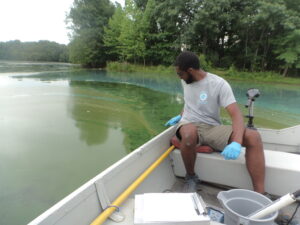
Cyanobacteria Screening
If bloom observed, a sample may be screened in several ways to determine if more quantitative analysis is necessary:
- Sample analyzed with handheld fluorometer. This device will measure the phycocyanin and chlorophyll a pigments to detect the presence and abundance of cyanobacteria
- Microscopic analysis to identify and confirm the presence of cyanobacteria taxa in the sample
Actions
If field survey screening indicates a likely bloom, samples will be collected for laboratory analysis of cell density and toxins. If a confirmed Harmful Algal Bloom is present with levels quantified at or above the NJ Health Advisory Guidance, BFBM and DWM&S management will be alerted and a monitoring plan will be developed. May include follow-up sampling in the frequency and duration necessary to confirm the continued presence or absence of the initial bloom.
Lake Monitoring Network
BFBM’s Lake Monitoring Network collects ambient water quality information for NJ lakes consisting of three components: Statewide statistical (probabilistic) survey, statewide reference lakes, and targeted regional lakes. If a bloom is suspected at a Lake Monitoring site, appropriate response actions will be taken.
Training
BFBM has various CyanoHAB monitoring and analysis capabilities, which are listed below. These capabilities allow NJDEP to confirm the presence of cyanobacteria and concentrations of toxins to provide accurate guidance on providing recreational action levels and health advisory guidance levels for analytical results.
Field Screening
- Visual Assessment
- Field Fluorometer for measuring Phycocyanin pigment (unique to cyanobacteria)
Other BFBM Laboratory Capability
- Cyanobacteria taxa identification
- Cyanobacterial cell counts
- Chlorophyll “a” analysis
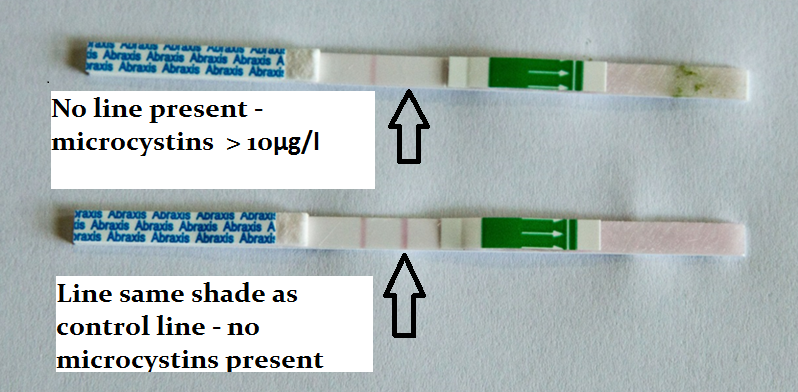
Cyanotoxin Analytical Capability
- Microcystins (approx. 65 variants)
- Method – ELISA (EPA Method 546 )
- Detection limit = 0.10 µg/L
- Reporting level = 0.15 µg/L
- Cylindrospermopsin
- Method – ELISA
- Detection limit = 0.040 µg/L
- Reporting level = 0.05 µg/L
- Anatoxin-a
- Method – ELISA
- Detection limit = 0.10 µg/L
- Reporting level = 0.15 µg/L
- Saxitoxin
- Method – ELISA
- Detection limit = 0.015 µg/L
- Reporting level = 0.02 µg/L
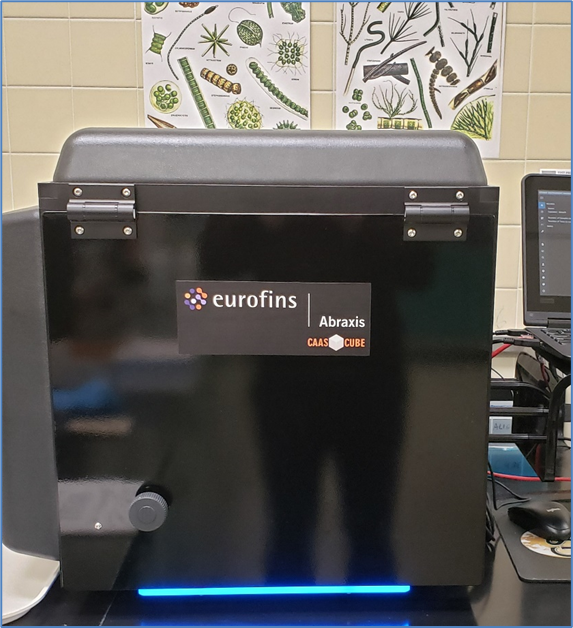
The DEP HAB Interactive Map Reporting and Communication System is used to gather initial information such as: location coordinates, photos, known recreational activities, and extent of the waterbody. This information will be used to inform DEP to initiate appropriate response actions. Once the DEP completes the investigation of the suspected HAB, results and any recommendations for public Alerts will be communicated through the HAB System.
2024 HAB Events
Click the button below to access the interactive map in the HABs System. All Alert information and HAB data will be accessible by clicking each point on the interactive map. The map reflects sampling results for suspected or confirmed HAB events reported to DEP; there may be other HABs occurring in NJ not shown here. HABs previously confirmed at a waterbody during the recreational season may persist or reoccur during the winter and caution should be taken. If you see a suspected HAB, avoid it & report it. In the case of a suspected bloom, people, pets and livestock should avoid contact with discolored water or water that has algae scums on the surface. Do not drink or consume the water. Do not eat fish from the waterbody. If there is contact with the water, rinse off as soon as possible with fresh water and seek medical or veterinary assistance if people or animals are experiencing adverse health effects after being exposed to a bloom. To review HAB events from 2020 and afterwards, click on the “Data Download” link at the bottom of the HAB Events Map. To see older data from the 2017, 2018, or 2019 HAB seasons, click on the Historic HAB Events link on the left side of this page.
